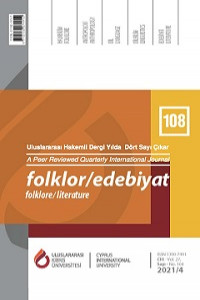Metinlerarasılık Bağlamında Anadolu’dan Avrupa’ya Âşıklar ve Anonim Eserler
Minstrels from Anatolia to Europe and Anonymous Works within the Context of Intertextuality
Author(s): Pınar Tekin, Füsun AtasevenSubject(s): Customs / Folklore, Music, Poetry, 15th Century, Translation Studies
Published by: Uluslararası Kıbrıs Üniversitesi
Keywords: intertextuality; intermusicality; minstrels; transformation translation;
Summary/Abstract: In this study, we aim to reveal the characteristics of the minstrel tradition, which has been going on in Anatolia for centuries and extending to the European continent, within the context of translation studies and intertextuality. The minstrels, who have an important role in shaping the culture in the lands they belong to, are the representatives of the region and the people they live in, and their role as a quoter makes them an element of the transformation/cycle. The minstrels, who are the mediators of Anatolian civilizations and rich works blended with the migrations they received from both the east and the west for centuries, are almost central in the context of intercultural interaction, as well as many ideas and art concepts produced and developed during this time, and the richness of cultural transformation is the focus of the research. In this study, in which I used document/work analysis within the framework of the qualitative research method, the different identities and works of minstrels in Anatolia and Europe adopted the context of translation studies and selected sample texts comparatively within the framework of intertextuality under the title of transtextuality, where Gerard Genette defines all kinds of relationships among texts. We tried to interpret it in the context of translation studies by taking it on the basis of these five concepts (intertextuality, hypertextuality, paratextuality, architextuality, metatextuality).
Journal: Folklor/Edebiyat
- Issue Year: 27/2021
- Issue No: 108
- Page Range: 1029-1044
- Page Count: 16
- Language: Turkish

